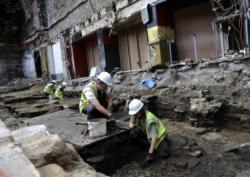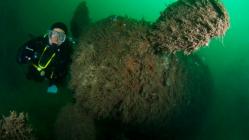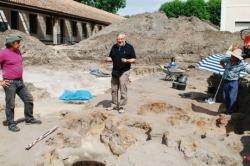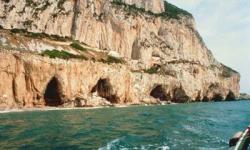INSTITUT SUPERIEUR D'ANTHROPOLOGIE
INSTITUTE OF ANTHROPOLOGY
ONLINE COURSES / COURS A DISTANCE
INSCRIPTION : Année Universitaire 2012/2013
REGISTRATION : Academic Year 2012 / 2013
ISRAEL –  - Hod Hasharon - An exceptional 1,300-year-old olive oil factory was unearthed Tuesday during excavations in the Tel Aviv suburb of Hod Hasharon. The Israel Antiquities Authority’s find, dated to the late Byzantine or early Muslim period, narrowly escaped being paved over by a planned roadway. Excavators found a pressing floor for olives, a piping system, trenches, and cisterns that drained and stored the fresh olive oil. Stone weights used for pressing sacks of olives were found beside the ruins. By the archaeologists’ estimations, the site was an industrial concern and not private. Archaeologist Amit Ram with the Israel Antiquities Authority told Maariv that the olive press was carved out of older building stones that were sunk into the earth. The Hod Hasharon olive press is an exceptional find because most olive presses are typically hewn out of the living rock already in the place, he said. In this case, however, the soft, red earth demanded that a solid foundation be constructed, so mason-worked blocks were imported to build the press.
- Hod Hasharon - An exceptional 1,300-year-old olive oil factory was unearthed Tuesday during excavations in the Tel Aviv suburb of Hod Hasharon. The Israel Antiquities Authority’s find, dated to the late Byzantine or early Muslim period, narrowly escaped being paved over by a planned roadway. Excavators found a pressing floor for olives, a piping system, trenches, and cisterns that drained and stored the fresh olive oil. Stone weights used for pressing sacks of olives were found beside the ruins. By the archaeologists’ estimations, the site was an industrial concern and not private. Archaeologist Amit Ram with the Israel Antiquities Authority told Maariv that the olive press was carved out of older building stones that were sunk into the earth. The Hod Hasharon olive press is an exceptional find because most olive presses are typically hewn out of the living rock already in the place, he said. In this case, however, the soft, red earth demanded that a solid foundation be constructed, so mason-worked blocks were imported to build the press.
http://www.timesofisrael.com/archaeologist-unearth-unique-1300-year-old-olive-oil-factory-outside-tel-aviv/
ROYAUME UNI –  Edinburgh - The buried secrets which lay beneath one of Edinburgh’s busiest nightspots have been uncovered by an archaeological dig in the Cowgate. Archaeologists digging in the historic Edinburgh street have discovered a series of buildings dating back to the 16th century and artefacts ranging from combs to a primitive board game. The last phase of excavation of the site, which is being developed by SoCo, has revealed the street frontages of the 16th-century buildings previously discovered. City council archaeologist John Lawson, told: “This part of the dig was the last piece of the puzzle – when all the discoveries are put together, I think it will be one of the most important archeological finds in Edinburgh. We’re getting evidence of 500 years of Edinburgh history, covering everything from early mansions of the rich to the slums of the 19th century.” The excavation is also believed to have uncovered the work of the famed Scottish archeological family the Adams. Among the finds are street frontage walls of 16/17th-century houses and later tenements, artefacts including pottery, bone comb and possible fragment of a gaming board and a complex of stone-lined drains.
Edinburgh - The buried secrets which lay beneath one of Edinburgh’s busiest nightspots have been uncovered by an archaeological dig in the Cowgate. Archaeologists digging in the historic Edinburgh street have discovered a series of buildings dating back to the 16th century and artefacts ranging from combs to a primitive board game. The last phase of excavation of the site, which is being developed by SoCo, has revealed the street frontages of the 16th-century buildings previously discovered. City council archaeologist John Lawson, told: “This part of the dig was the last piece of the puzzle – when all the discoveries are put together, I think it will be one of the most important archeological finds in Edinburgh. We’re getting evidence of 500 years of Edinburgh history, covering everything from early mansions of the rich to the slums of the 19th century.” The excavation is also believed to have uncovered the work of the famed Scottish archeological family the Adams. Among the finds are street frontage walls of 16/17th-century houses and later tenements, artefacts including pottery, bone comb and possible fragment of a gaming board and a complex of stone-lined drains.
http://www.scotsman.com/edinburgh-evening-news/cowgate-discoveries-unearth-edinburgh-s-hidden-history-1-2455638
ROYAUME UNI –  Eastbourne - The Nautical Archaeology Society and the Tunbridge Wells Sub Aqua Club will be marking the anniversary of the loss of the Holland 5 submarine - the Royal Navy's oldest submarine wreck - with a dive 100 years to the day after its loss. Hundreds of years of maritime activity, two World Wars and numerous seafaring accidents have seen the seas and shores around the south coast become steeped in legend and undiscovered pockets of history. One piece of naval history that remained undiscovered until 1995 was the Holland 5 submarine. Lying, upright in 30 metres of water, the Holland 5 was one of the Royal Navy's first submarines accepted for service, alongside the Holland 1 now on display at the Royal Navy Submarine Museum in Gosport. The Holland 5 was commissioned on the January 19 1903. However, the Holland series of submarines rapidly became obsolete and on the August 8 1912 she was being towed to Sheerness for decommissioning and sank in her current position off the coast of Eastbourne, six miles southeast of the Royal Sovereign Lighthouse. There was no loss of life when the Holland 5 sank, just a loss of the most intact example of the Holland series of submarines. The cause of the sinking was believed to be as a result of flooding through a torpedo hatch and she lay undiscovered for almost a century.
Eastbourne - The Nautical Archaeology Society and the Tunbridge Wells Sub Aqua Club will be marking the anniversary of the loss of the Holland 5 submarine - the Royal Navy's oldest submarine wreck - with a dive 100 years to the day after its loss. Hundreds of years of maritime activity, two World Wars and numerous seafaring accidents have seen the seas and shores around the south coast become steeped in legend and undiscovered pockets of history. One piece of naval history that remained undiscovered until 1995 was the Holland 5 submarine. Lying, upright in 30 metres of water, the Holland 5 was one of the Royal Navy's first submarines accepted for service, alongside the Holland 1 now on display at the Royal Navy Submarine Museum in Gosport. The Holland 5 was commissioned on the January 19 1903. However, the Holland series of submarines rapidly became obsolete and on the August 8 1912 she was being towed to Sheerness for decommissioning and sank in her current position off the coast of Eastbourne, six miles southeast of the Royal Sovereign Lighthouse. There was no loss of life when the Holland 5 sank, just a loss of the most intact example of the Holland series of submarines. The cause of the sinking was believed to be as a result of flooding through a torpedo hatch and she lay undiscovered for almost a century.
http://www.itv.com/news/meridian/2012-08-08/oldest-submarine-wreck/
ROYAUME UNI – Aberdeen – Amateur archaeologists will join forces with professionals this summer for a Time Team-style dig to unearth the historic secrets of Aberdeen's Tullos Hill. The hill has long been known as an important archaeological site because of the four Bronze Age burial cairns there: Cat Cairn; Baron's Cairn; Crab's Cairn; and Tullos Cairn, which are scheduled as monuments of national significance. At the other end of the historic timeline Tullos Hill was the location of an anti-aircraft battery and later a prisoner of war camp in World War II. A few remnants of hut bases from that era survived on the hill. For many years it was thought that landfill operations since the 1960s had destroyed any other historic remains, but a survey by archaeologists from CFA Archaeology in 2004 recorded the presence of around 150 other archaeological features, ranging in date from prehistory to World War II.
http://www.aberdeencity.gov.uk/CouncilNews/ci_cns/pr_tullos_dig_080812.asp
INDE - Karumadi / Mavelikkara - The Department of Archaeology set to give a facelift to two important statues of Lord Buddha at Karumadi and Mavelikkara in the district. These 1,000-year-old statues belonging to the 9th and 10th century are lying in a neglected state. Cultural affairs minister K C Joseph has said a project for protecting these two monuments will begin in September. It was Karumadikuttans, a cultural forum from Karumadi, which highlighted the plight of the monuments and brought it to the attention of the cultural affairs minister K C Joseph. The department's director J Reji Kumar said: "Renovation work, setting up of information counters, gardens, water falls children's park will be carried out. Additionally, a special wing will be set up for monitoring these activities.'' "The three-foot long statue is located in a temple at Buddha Junction in Mavelikkara. We will also conduct various construction activities for attracting more people to this place,'' Reji Kumar said. Lord Buddha's 1,200-year-old statue at Karumadi is known as Karumadikuttan. Located at a distance of 19 km from Alappuzha, this statue is made from black granite. The left hand of this statue is broken and missing. It is almost three feet in height.
http://timesofindia.indiatimes.com/city/kochi/Buddha-statues-await-renovation/articleshow/15397632.cms
FRANCE –  La Teste de Buch - Le sous-sol de l'ancienne école Gambetta vient de livrer ses secrets à Philippe Jacques, qui a été missionné par la Drac pour effectuer des fouilles préventives. On a découvert deux phases d'occupation, l'une médiévale avec un bâti du XIVe siècle, et l'autre du XVIIe. L'archéologue de commenter : « On a découvert huit barriques qui ont été volontairement et de façon systématique implantées dans la couche d'alios et dans la nappe phréatique. Le fond avait été enlevé sciemment, ceci indique une activité artisanale mais, pour l'instant, on ne sait pas laquelle, les analyses du bois sont nécessaires. » Il avance très prudemment l'hypothèse d'une teinturerie ou d'une tannerie… Un grand bac à chaux a été mis à jour, il date du XVIIe siècle ; creusé dans l'alios, on peut voir les petites bulles qui se forment quand on mélange la chaux vive à l'eau. Philippe Jacques pense qu'il a dû être utilisé pour la construction d'un grand bâtiment, sans doute l'église toute proche qui a été reconstruite à cette époque.
La Teste de Buch - Le sous-sol de l'ancienne école Gambetta vient de livrer ses secrets à Philippe Jacques, qui a été missionné par la Drac pour effectuer des fouilles préventives. On a découvert deux phases d'occupation, l'une médiévale avec un bâti du XIVe siècle, et l'autre du XVIIe. L'archéologue de commenter : « On a découvert huit barriques qui ont été volontairement et de façon systématique implantées dans la couche d'alios et dans la nappe phréatique. Le fond avait été enlevé sciemment, ceci indique une activité artisanale mais, pour l'instant, on ne sait pas laquelle, les analyses du bois sont nécessaires. » Il avance très prudemment l'hypothèse d'une teinturerie ou d'une tannerie… Un grand bac à chaux a été mis à jour, il date du XVIIe siècle ; creusé dans l'alios, on peut voir les petites bulles qui se forment quand on mélange la chaux vive à l'eau. Philippe Jacques pense qu'il a dû être utilisé pour la construction d'un grand bâtiment, sans doute l'église toute proche qui a été reconstruite à cette époque.
http://www.sudouest.fr/2012/08/08/huit-barriques-et-un-bac-a-chaux-sous-l-ecole-789544-2780.php
FRANCE – Villeneuve d’Ascq - La ferme Delporte, qui abrite le Musée du Terroir et la Société Historique de Villeneuve d'Ascq et du Mélantois (SHVAM). Tout d'abord, c'était une cense, c'est-à-dire un bâtiment loué par un seigneur à un locataire, qui devait verser une rente, en nature ou en monnaie. La ferme date de 1720. Si, à première vue, son architecture semble classique, elle recèle quelques indices d'une histoire plus ancienne. « Date de création inconnue » Dans la façade, certaines briques, de tailles différentes, datent du XVIe siècle. Ce n'est pas tout : on y trouve aussi une très ancienne cave, qui date du XIIIe siècle. « On sait que le bâtiment a été agrandi en 1730. La date de création est inconnue, on suppose XIIIe siècle pour les parties les plus anciennes, comme la cave. Il y avait deux granges, c'était une vraie usine à céréales. On stockait des gerbes de blé dans l'une et des patates dans l'autre ». Les travaux Delporte intéressaient beaucoup les archéologues de l'INRAP (Institut National de Recherches Archéologiques Préventives, ndlr). Il y avait déjà eu des fouilles auparavant, dont la découverte de céramique et la trouvaille du puits ».
http://www.nordeclair.fr/Locales/Villeneuve-d-Ascq/2012/08/08/delporte-les-chevaux-de-course-du-comte.shtml
GIBRALTAR –  – Recently, as part of the wider Gibraltar Caves Project, which was started in 1991,the Cave Unit of the Gibraltar Museum has been working with volunteers in the surveying of Gibraltar’s caves. This is specialised work which is carried out under supervision and is already producing excellent results. The unit is preparing an inventory of Gibraltar’s caves, checking previous work done and looking at each site today. The number of caves now exceeds 200! Part of the work involves assessing the archaeological and palaeontological potential of each site. Some of these caves were last excavated in the 19th Century, so determining how much archaeology is left is a major challenge. Others were excavated in the 1960s by the late Mr George Palao, and the unit has not only used Mr Palao’s reports which are in the archives of museum, but has also met with some of his collaborators in order to obtain as much information as possible. The unit is also in contact with – and collaborating with - the GONHS Cliffs and Caves Section who have also worked a number of Gibraltar’s caves.
– Recently, as part of the wider Gibraltar Caves Project, which was started in 1991,the Cave Unit of the Gibraltar Museum has been working with volunteers in the surveying of Gibraltar’s caves. This is specialised work which is carried out under supervision and is already producing excellent results. The unit is preparing an inventory of Gibraltar’s caves, checking previous work done and looking at each site today. The number of caves now exceeds 200! Part of the work involves assessing the archaeological and palaeontological potential of each site. Some of these caves were last excavated in the 19th Century, so determining how much archaeology is left is a major challenge. Others were excavated in the 1960s by the late Mr George Palao, and the unit has not only used Mr Palao’s reports which are in the archives of museum, but has also met with some of his collaborators in order to obtain as much information as possible. The unit is also in contact with – and collaborating with - the GONHS Cliffs and Caves Section who have also worked a number of Gibraltar’s caves.
http://www.panorama.gi/